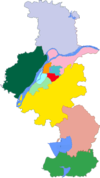You can help expand this article with text translated from the corresponding article in Chinese. (November 2008) Click for important translation instructions.
|
| Nanjing Yangtze River Bridge 南京长江大桥 | |
|---|---|
 Nanjing Yangtze River Bridge, looking from the southeast bank to the northwest view. Nanjing Yangtze River Bridge, looking from the southeast bank to the northwest view. | |
| Coordinates | 32°06′55″N 118°44′20″E / 32.1152°N 118.7388°E / 32.1152; 118.7388 |
| Carries | |
| Crosses | Yangtze River |
| Locale | Nanjing, Jiangsu China |
| Owner |
|
| Characteristics | |
| Design | Double-decked truss bridge |
| Material | Steel |
| Total length | Main Bridge: 1,576 metres (5,171 ft) Highway: 4,588 metres (15,052 ft) Railway: 6,772 metres (22,218 ft) |
| Width | Highway Bridge: 19.5 metres (64 ft) (with 4.5 metres (15 ft) pedestrian path) Railway: 14 metres (46 ft) |
| Height | 70 metres (230 ft) |
| Longest span | 160 metres (525 ft) |
| No. of spans | 10 |
| Piers in water | 9 |
| Clearance below | 24 metres (79 ft) |
| History | |
| Designer | Ministry of Railways |
| Construction start | 18 January 1960 |
| Construction end |
|
| Replaces | Yangtze River Railway Ferry |
| Statistics | |
| Daily traffic | 80,000 vehicles 200 pairs of trains |
| Location | |
The Nanjing Yangtze River Bridge (simplified Chinese: 南京长江大桥; traditional Chinese: 南京長江大橋; pinyin: Nánjīng Chángjiāng Dàqiáo), previously called the First Nanjing Yangtze Bridge, is a double-decked road-rail truss bridge across the Yangtze River in Nanjing, Jiangsu, China connecting the city's Pukou and Gulou districts. Its upper deck is part of China National Highway 104, spanning 4,588 metres (15,052 ft). Its lower deck, with a double-track railway, is 6,772 metres (22,218 ft) long, and completes the Beijing–Shanghai railway, which had been divided by the Yangtze for decades. Its right bridge consists of nine piers, with the maximum span of 160 metres (525 ft) and the total length of 1,576 metres (5,171 ft). The bridge carries approximately 80,000 vehicles and 190 trains per day.
The bridge was completed and open for traffic in 1968. It was the third bridge over the Yangtze after the Wuhan Yangtze River Bridge and the Chongqing Baishatuo Yangtze River Bridge. It was the first heavy bridge designed and built using Chinese expertise.
Suicide site
See also: List of suicide sitesAccording to state media, the Nanjing Yangtze River Bridge surpassed the Golden Gate Bridge as the most frequent suicide site in the world, with more than 2,000 suicides estimated by 2006.
People who have survived the jump have had severe consequences including paralysis, organ damage, broken bones and lifelong pain. Most think that jumping will lead to an instant death but for many death is not instant.
Gallery
-
 Vehicles on the Nanjing Yangtze River Bridge
Vehicles on the Nanjing Yangtze River Bridge
-
Statue of first Yangtze river bridge at Nanjing
-
Scenery on the Yangtze river
-
 Nanjing Yangtze River Bridge seen from the upstream right bank
Nanjing Yangtze River Bridge seen from the upstream right bank
-
Perspective of the double-column frame piers of the railway bridge approach structure
-
 The Nanjing Yangtze Bridge in 2022
The Nanjing Yangtze Bridge in 2022
See also
- Dashengguan Yangtze River Bridge Nanjing's other railway bridge that carries the Beijing–Shanghai High-Speed Railway.
- Yangtze River bridges and tunnels
- List of bridges in China
- Beijing–Shanghai Railway
- Rail transport in China
- Passenger rail transport in China
References
- Notes
- Sun Xiaoyu (September 28, 2006). 2000自杀者为何选择南京长江大桥? [Why have 2,000 people killed themselves at the Nanjing Yangtze River Bridge?]. People's Daily (in Chinese). Archived from the original on February 19, 2015. Retrieved January 12, 2015.
- Bondi, OnScene (2024-01-26). "The other side of suicide". OnScene ACT. Retrieved 2024-03-11.
- Bibliography
- Gao Mobo (2008). The Battle for China's Past: Mao and the Cultural Revolution. Pluto Press: Verso. ISBN 978-0-7453-2780-8.
External links
- 纪录片《南京长江大桥》 Nanjing Yangtze River Bridge Documentary (1969)(in Chinese)
- How to get to the Yangtze River Bridge
- Yangtze River Bridge: The Historic Landmark of Modern Nanjing
| Jiangsu topics | |
|---|---|
| Nanjing (capital) | |
| General | |
| Geography | |
| Education | |
| Culture |
|
| Visitor attractions | |
| Crossings of the Yangtze River | ||||
|---|---|---|---|---|
| ||||
